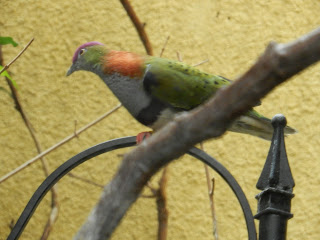One row of aviaries at the London Zoo houses some large birds, such as this woolly-necked stork.
An African harrier hawk and its lunch. This species is known for its "double-jointed" ankle, which helps it to reach into crevices to capture prey.
A striated caracara, a scavenging falcon from the Tierra del Fuego archipelago.
The London Zoo houses two species of penguin: Humboldt and northern rockhopper. Both are visible in this photo, but the Humboldt might take some searching to spot.
I tried to get some good photos of the blue-throated macaws, a species I hadn't seen before, but was unsuccessful.
A vicuña, the wild ancestor of the alpaca.
A newly-opened exhibit at the zoo showcases their lions. It's a good exhibit, but not even the fact that they had the Asiatic subspecies of lion (which I'd already seen at the Bristol Zoo) was enough to draw me away from this magnificent Rüppell's griffon vulture.
The Blackburn Pavilion is home to many species of tropical birds. Much of this building appears to be a walkthrough aviary and was thus closed during my visit, but a number of displays near the entrance remained open for viewing. Among its residents is this superb fruit dove (which is actually the name of its species and not merely my own description of it, apt though it is).
A hooded pitta.
A beautiful fruit dove (again, the actual name of this species), marred somewhat by the fine wire mesh.
A Mindanao bleeding heart dove.
A male crested partridge. I've found that the coloration of this species blends well into the lighting of forested environments, which makes getting clear photos of them fairly difficult.
A male red-legged honeycreeper. Not a close relative of the famous Hawaiian honeycreepers (which are finches), but a tanager.
An orange-headed thrush.
The Casson Pavilion is home to a rather miscellaneous variety of animals, including this large hairy armadillo. Armadillos are surprisingly active when they're awake; it took me many tries to get a photo that wasn't (too) blurry.
The pavilion provides indoor retreats for some animals that also have outdoor exhibits, such as these Malayan tapirs.
Despite signs claiming that this exhibit was empty, this rock hyrax was present.
A yellow mongoose. In the wild, this species may share burrow systems with meerkats and Cape ground squirrels.
Just outside, the tiger exhibit is accompanied by some humorous signage.
Gorilla Forest displays gorillas, as you can guess, but it has many other species of primates as well. This is a white-naped mangabey.
More importantly, it also exhibits some African bird species, like this green woodhoopoe.
A northern helmeted curassow, which is... South American, not African. Hmm.
Subscribe to:
Post Comments (Atom)




































I found the Humboldt!
ReplyDeleteAssuming this was taken on a cloudy day, the humboldt is in the nest box.
You got it. It was a cloudy day indeed and it even rained a few times. Cloudy days make some of the best zoo trips, in my experience, but I could have done without the rain.
DeleteI also went to the London Zoo, and when I did, at the somewhat 20 minutes after the reptile house, I saw a sign saying Green Woodhoopoe, but as I got closer, It was a different sign!
ReplyDelete#shapeshifting #london #zoo #londonzoo# #sign
They also have the curassow in the rainforest house.
ReplyDeleteThat would make more sense. I didn't see them there during my visit; I wonder if they'd been temporarily moved out due to the bird flu scare at the time.
DeleteWhat is your favourite UK Zoo?
ReplyDeleteI've only been to Bristol, London, and a couple of the WWT Wetland Centres, but they've all been really good!
Delete